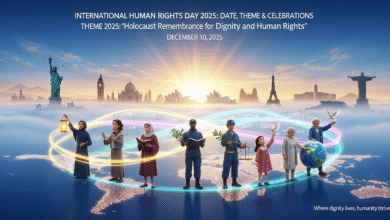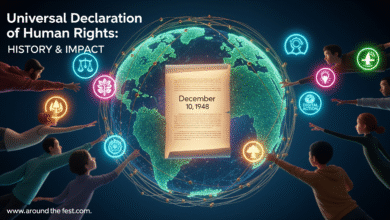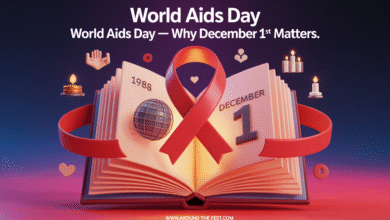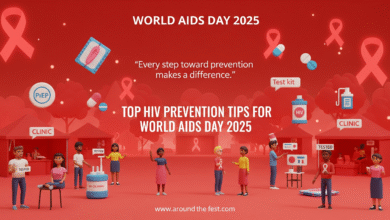World AIDS Day 2025 Events and Activities Guide
World AIDS Day 2025 Events: A Global Call to Action
World AIDS Day 2025 events provide a unique and powerful opportunity for communities around the world to unite in the fight against HIV/AIDS. Observed each year on December 1st, World AIDS Day raises awareness, honors those living with HIV, and promotes actions that prevent and effectively treat the virus.
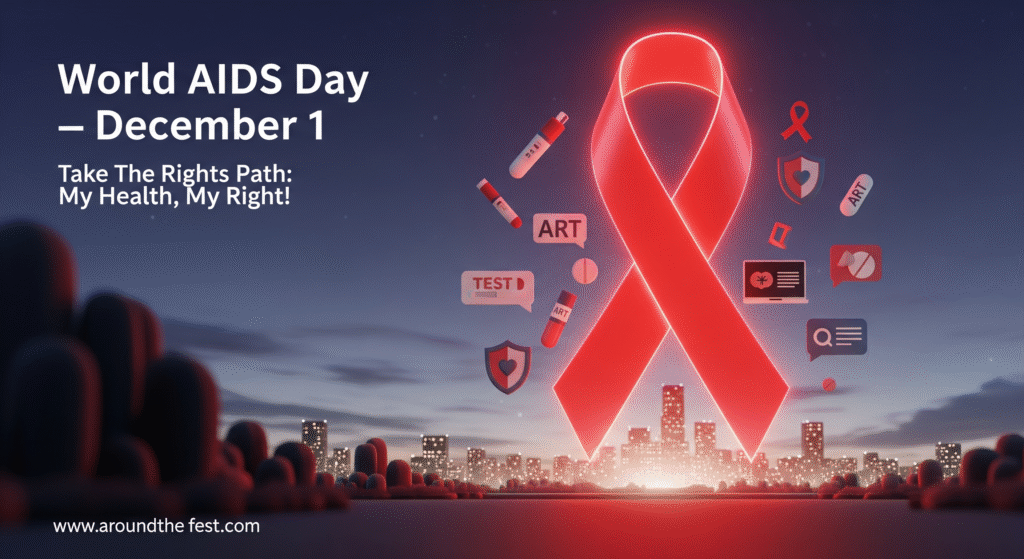
Theme and Significance
The 2025 theme, has not yet been officially announced by the WHO OR UN ,but it must emphasizes the importance of access to accurate health information, testing, and treatment. Therefore, participation in these events is crucial for both individuals and communities worldwide.
Range of Activities in World AIDS Day 2025 Events
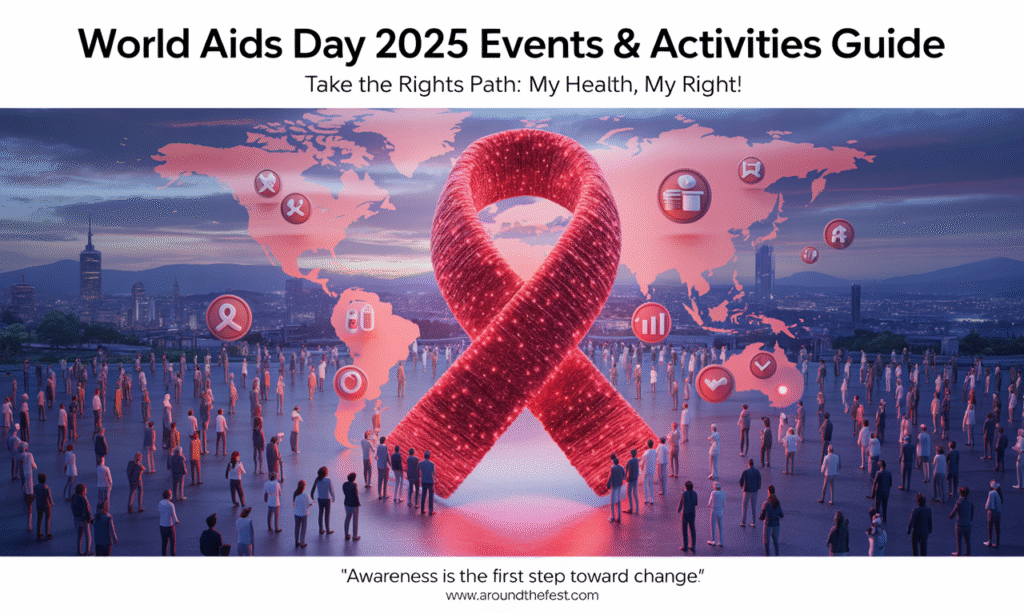
These World AIDS Day 2025 events include many activities designed to educate, involve, and empower people of all ages. For example, local workshops and seminars, major fundraisers, public awareness campaigns, and cultural programs showcase the latest developments in HIV research, prevention strategies, and care.
In addition, virtual initiatives allow people worldwide to participate. They can share knowledge, support advocacy, and help reduce stigma associated with HIV/AIDS effectively. Furthermore, these initiatives create opportunities for global engagement and collaboration.
Taking Proactive Action
Participating in World AIDS Day 2025 goes beyond attending programs. It requires taking meaningful, proactive steps. Schools, communities, NGOs, and government organizations collaborate to provide inclusive platforms. Here, participants can learn about preventive measures, access credible information, and actively support advocacy projects.
Moreover, social media campaigns spread awareness further. They encourage informed discussions on HIV prevention and connect participants with reliable resources for continued engagement. Additionally, these campaigns help reach audiences who cannot attend events in person.
Ultimately, World AIDS Day 2025 serve as a global call to action. They offer chances to join educational initiatives, fundraising efforts, awareness campaigns, and advocacy programs. These activities promote health equity, empower communities, and encourage shared responsibility.
By taking part, individuals contribute to a worldwide movement. Together, they help reduce HIV infections, fight stigma, and build stronger, informed communities ready to tackle HIV/AIDS now and in the near future.
What Are World AIDS Day 2025 Events and Activities?
World AIDS Day 2025 events and activities are part of an annual global initiative observed on December 1st to raise awareness about HIV/AIDS, honor those living with the virus, and promote preventive measures and treatment. World AIDS Day, first observed in 1988, was established to bring together communities, governments, and organizations globally to combat HIV. Over the years, these events have grown into diverse activities ranging from educational programs to fundraising and cultural initiatives, all aimed at reducing stigma and increasing access to care.
The 2025 theme,has not yet been officially announced by the WHO OR UN, highlights the fundamental importance of health equity. It emphasizes that every individual has the right to accurate information, HIV testing, and treatment services, regardless of their location or background. This theme guides the focus of World AIDS Day 2025 events, ensuring that participants understand both their rights and responsibilities in preventing and managing HIV. By aligning events with this theme, organizers encourage communities to actively engage in advocacy, education, and support programs.
Globally, HIV/AIDS remains a significant public health challenge. According to the latest UNAIDS data, approximately 39 million people worldwide are living with HIV, and nearly 1.5 million new infections occur annually. These statistics underscore the importance of raising awareness through events and campaigns.
Benefits of Attending or Participating in World AIDS Day 2025 Events
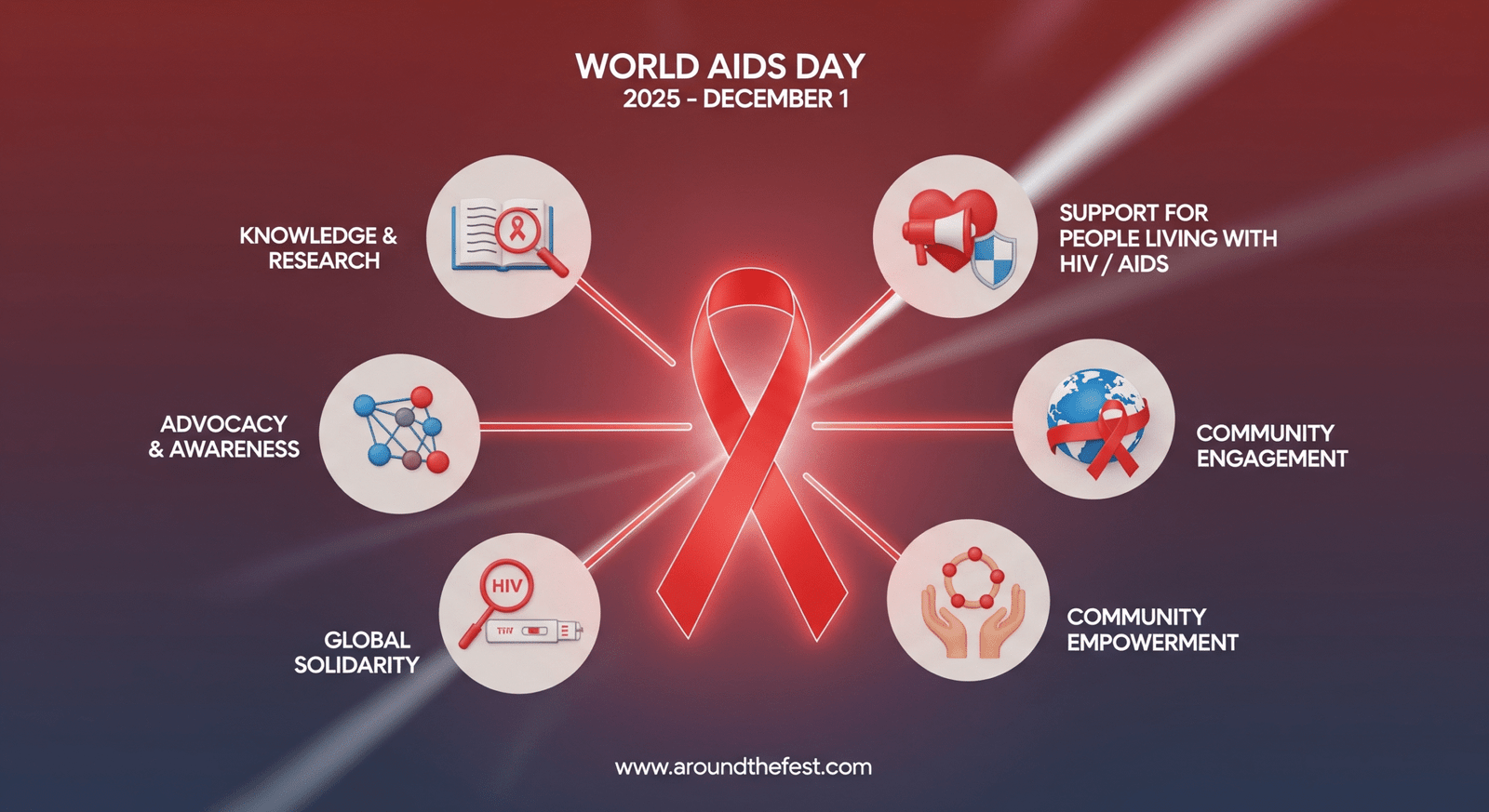
Gain Accurate Knowledge: Learn about HIV prevention, treatment options, and the latest research to make informed health decisions.
Support People Living with HIV/AIDS: Reduce stigma, show solidarity, and promote understanding within your community.
Contribute to Advocacy and Awareness: Participate in fundraisers, workshops, and awareness campaigns to spread vital information.
Foster Community Engagement: Connect with healthcare professionals, activists, volunteers, and like-minded individuals for collaboration and networking.
Promote Global Solidarity: Understand that your actions—attending events or joining virtual campaigns—support worldwide efforts to fight HIV/AIDS.
Encourage Preventive Action: Inspire others to get tested, adopt safe practices, and actively participate in health initiatives.
Empower Communities: Help build stronger, informed, and proactive communities capable of supporting affected individuals and promoting health equity.
Ultimately, World AIDS Day 2025 events and activities serve as more than symbolic gestures—they are practical, actionable opportunities for individuals and communities to contribute to global HIV awareness, prevention, and care. By participating, everyone can help create informed, compassionate, and proactive communities ready to tackle HIV/AIDS effectively.
How to Participate in World AIDS Day 2025 Events and Activities
World AIDS Day 2025 isn’t just about remembering — it’s about active participation. Whether you want to get involved locally or globally, there are plenty of meaningful ways to contribute. Here’s how you can take part:
1. Attend Local Awareness Events
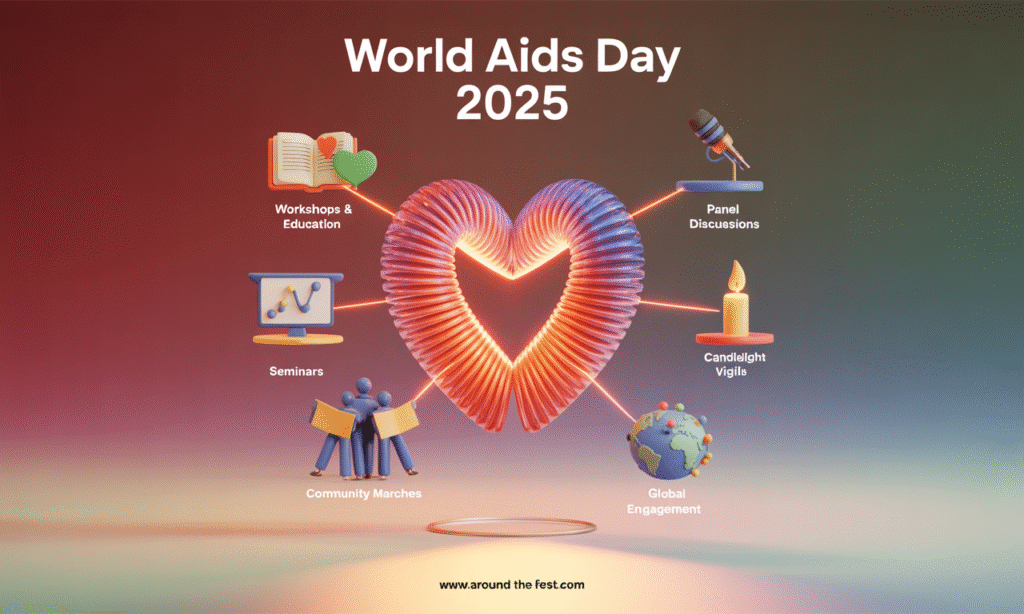
Community-based gatherings are at the heart of World AIDS Day. These events provide safe spaces for dialogue, education, and support.
Workshops
Workshops are interactive sessions designed to educate participants on HIV prevention, treatment options, and stigma reduction. They often include hands-on activities, role-playing scenarios, and group discussions. For example, attendees might practice counseling techniques, learn to conduct community outreach, or explore the latest HIV testing technologies. Workshops are ideal for small groups, fostering open dialogue and active participation.
Panel Discussions
Panels typically feature experts such as doctors, researchers, activists, and individuals living with HIV. These discussions cover topics ranging from advances in antiretroviral therapy to policy changes and global health strategies. Participants can ask questions, hear diverse perspectives, and gain insights into both scientific developments and personal experiences. Panels are highly effective at highlighting current challenges and innovative solutions.
Seminars
Seminars are formal presentations that provide in-depth knowledge on HIV/AIDS, public health strategies, and preventive measures. They often include lectures, case studies, and Q&A sessions. Seminars can take place in schools, universities, community centers, or online, making them accessible to a wide audience. They are particularly useful for delivering evidence-based information and ensuring participants leave with actionable knowledge.
Candlelight Vigils
Vigils are solemn events held to honor those who have lost their lives to HIV/AIDS. Participants gather to light candles, observe moments of silence, and share personal stories. Candlelight vigils are powerful emotional experiences that foster solidarity, remembrance, and community support. They also serve as public statements against stigma and discrimination.
Marches
Public marches unite communities in a visible show of support and advocacy. Participants often carry banners, wear red ribbons, and distribute educational materials. Marches raise public awareness, attract media attention, and demonstrate a collective commitment to HIV prevention and treatment. They are highly symbolic, empowering communities to take an active stance in promoting health equity and social justice.
Why It Matters: These events spread accurate information, reduce stigma, and build a sense of community support.
Examples from Previous Years:
- In South Africa, community vigils honored lives lost to AIDS while spreading awareness about prevention.
- In Canada, schools and universities hosted HIV education seminars and student-led discussions.
- In New York City, community marches highlighted the fight for equal healthcare access.
2. Join Fundraisers and Charity Activities
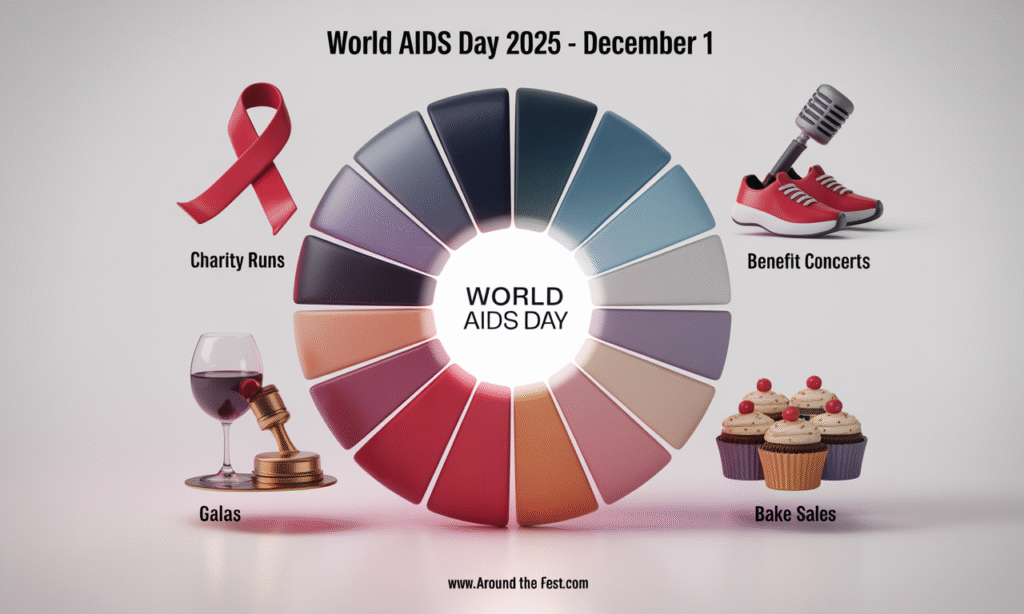
Fundraising is a powerful way to support HIV research, treatment programs, and community outreach initiatives.
Charity Runs
Charity runs, such as 5K or 10K events, combine fitness with advocacy. Participants often wear red ribbons or themed apparel to show solidarity. These runs raise funds through entry fees and sponsorships while spreading public awareness along the race route.
Benefit Concerts
Music concerts and live performances draw large audiences and use entertainment as a platform for advocacy. Artists may share information about HIV prevention, honor affected communities, or donate a portion of ticket sales to HIV organizations. These events help engage diverse audiences who might not attend traditional awareness activities.
Galas
Formal charity galas, such as the amfAR Venice Gala, are high-profile events that raise millions for HIV research and treatment programs. Galas often include auctions, speeches, performances, and networking opportunities, creating both fundraising and awareness platforms for attendees and sponsors.
Bake Sales
Smaller-scale but highly effective, bake sales are organized by local communities, schools, or NGOs. They provide a hands-on way for people to participate, donate, and engage with their neighbors while supporting HIV-related initiatives.
3. Online Donation Campaigns & Crowdfunding Drives
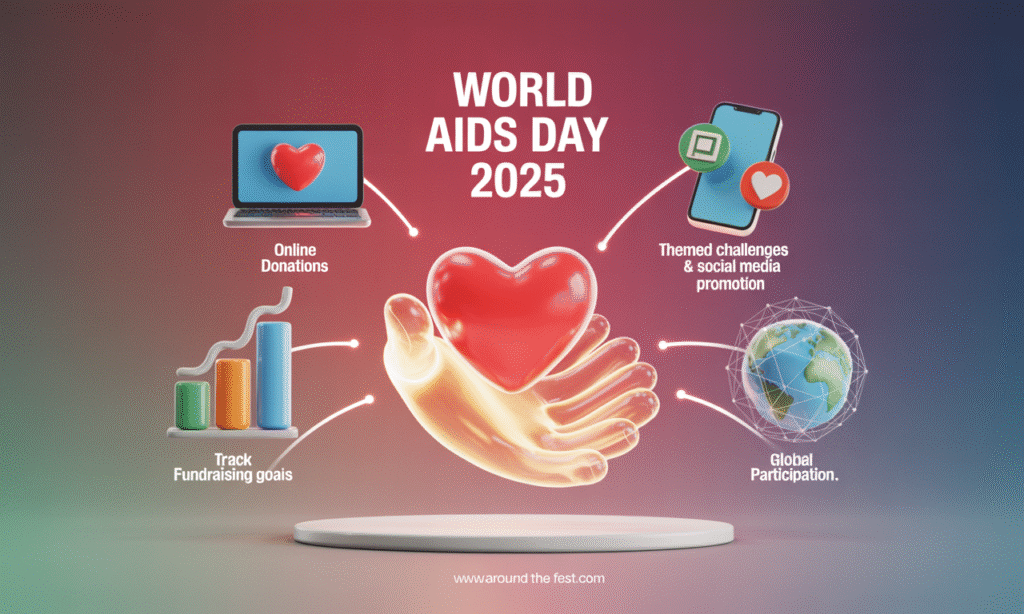
Digital platforms allow global participation, making it easy for anyone to contribute from anywhere. Campaigns can include themed challenges, social media promotion, or crowdfunding platforms where people can share personal stories, match donations, and track progress toward fundraising goals.
Why It Matters: Every contribution funds lifesaving work — from providing access to medicine in underserved regions to supporting large-scale prevention programs.
Examples:
amfAR Venice Gala: An internationally renowned charity event that raises millions of dollars annually to support HIV/AIDS research and advocacy.
Local Runs & Walks: Many cities organize 5K runs or awareness walks, where participation itself becomes a form of activism.
Online Campaigns: Digital fundraisers allow global participation, giving people the chance to contribute no matter where they are.
4. Participate in Educational and Outreach Programs
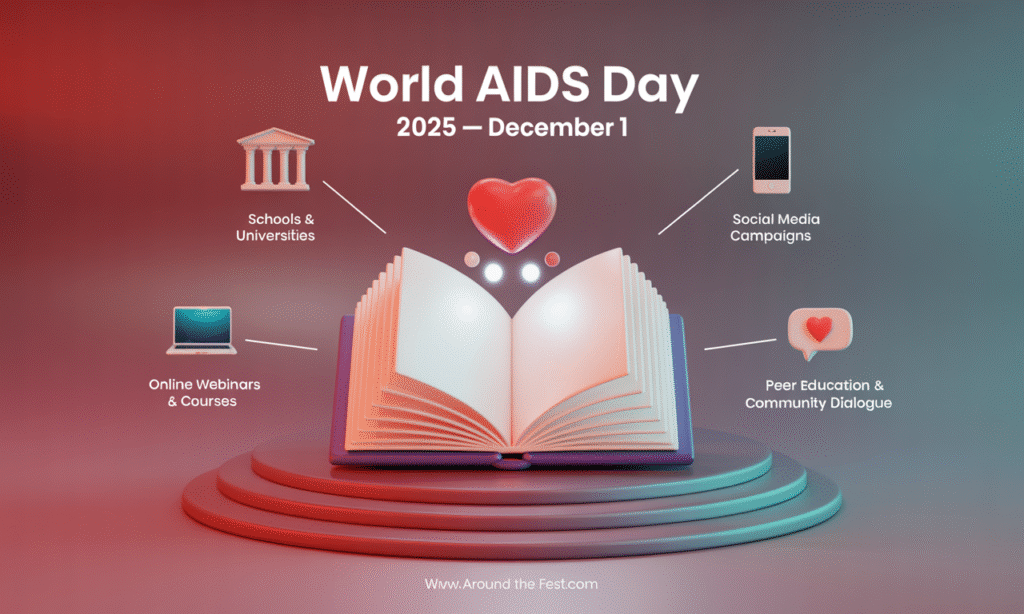
Education plays a vital role in both prevention and breaking stigma, and World AIDS Day highlights the power of learning and sharing knowledge.
Schools & Universities
Many institutions organize programs with guest speakers, interactive workshops, and student-led awareness projects. These initiatives often include competitions, debates, poster campaigns, and peer education activities. By involving students, schools and universities foster early awareness, encourage leadership in advocacy, and build long-lasting community engagement.
Online Webinars & Courses
Expert-led online sessions provide accessible education on HIV prevention, treatment options, and the human rights of people living with HIV. Webinars may feature doctors, researchers, or activists and often include Q&A sessions, discussion forums, and downloadable resources. Online courses allow participants from around the world to gain structured, evidence-based knowledge while engaging in global conversations.
Social Media Campaigns
Social media platforms are powerful tools to spread awareness and engage wider audiences. Participants can share infographics, survivor stories, educational videos, or fact sheets. Using official hashtags like #WorldAIDSDay2025 helps amplify messages, connect communities, and encourage dialogue about prevention, testing, and treatment. Social media campaigns also allow individuals who cannot attend physical events to participate meaningfully.
Why It Matters: Informed communities are empowered communities — and education directly saves lives.
Examples:
- The global #KnowYourStatus campaign encouraged millions of people to get tested for HIV.
- Universities across Europe and North America have hosted week-long educational series leading up to December 1.
5. Engage in Cultural and Creative Activities
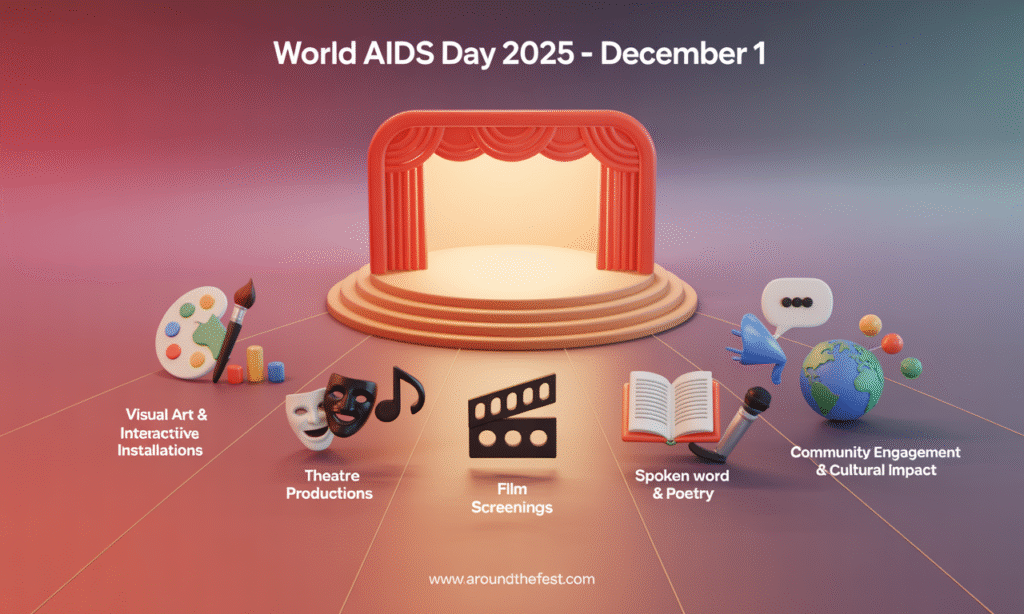
Art and culture are powerful tools for social change, often breaking down barriers that facts and data alone cannot.
Creative showcases
Play a crucial role in World AIDS Day 2025 events by combining art, culture, and advocacy to raise awareness about HIV/AIDS. These activities go beyond traditional education methods, using emotional and visual storytelling to connect with audiences and inspire action.
Visual Art & Interactive Installations
Art exhibitions and interactive installations provide a powerful platform to depict the experiences of people living with HIV/AIDS. Visitors can engage with thought-provoking pieces that highlight resilience, struggles, and triumphs. Interactive installations may allow participants to contribute to the artwork, symbolizing community involvement and solidarity.
Music Performances
Live concerts and music festivals integrate HIV awareness into their programs, blending entertainment with advocacy. Artists often dedicate performances to affected communities or use the event to share educational messages. Music appeals to a wide audience and creates an emotional connection that can make the cause more memorable.
Theatre Productions:
Theatre performances bring real-life stories to the stage, portraying the challenges and triumphs of those affected by HIV/AIDS. Local youth groups or professional theatre companies often create plays that explore themes such as stigma, resilience, and inclusion. These performances encourage empathy and spark meaningful discussions among audiences.
Film Screenings
Documentaries, short films, and feature films focused on HIV/AIDS educate viewers about the global epidemic, prevention strategies, and personal stories of those impacted. Post-screening discussions or Q&A sessions with filmmakers, health experts, or activists provide further learning opportunities.
Spoken Word & Poetry
Spoken word events give individuals a platform to share personal experiences, reflections, and messages of hope. These performances humanize the epidemic, reduce stigma, and foster emotional engagement. They often appeal to younger audiences and help amplify voices that are underrepresented in traditional awareness campaigns.
Why It Matters: Creative activities reach wider audiences, especially youth, and help reduce stigma through storytelling and emotional connection.
Examples:
Music festivals across Latin America have incorporated HIV awareness campaigns directly into their performances, reaching wide audiences in engaging ways.
Youth groups around the world organize theatre and dance performances that explore themes of resilience, inclusion, and hope, while raising awareness about HIV/AIDS.
Art galleries in Europe and Asia have displayed works highlighting the fight against HIV/AIDS and celebrating resilience in affected communities.
5 Simple Ways to Take Part in World AIDS Day 2025
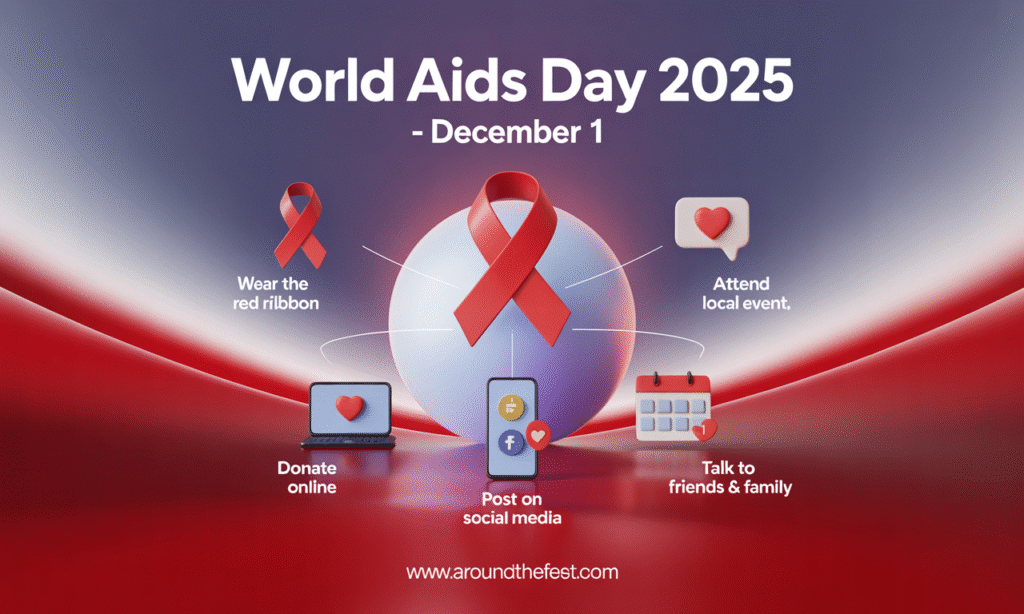
If you’re looking for simple yet powerful ways to get involved, here are five beginner-friendly ideas:
Wear the Red Ribbon – Show your support visibly and spark important conversations.
Donate Online – Even a small contribution to trusted organizations like UNAIDS or amfAR makes a difference.
Post on Social Media – Share an infographic, survivor story, or fact with hashtags like #WorldAIDSDay2025.
Attend a Local Event – Look up vigils, workshops, or marches happening in your community.
Talk to Friends & Family – Start conversations to spread awareness, fight stigma, and encourage empathy within your circle.
Global Events You Can Join – World AIDS Day 2025
World AIDS Day 2025 offers diverse ways to participate globally. From local community initiatives to international campaigns, every contribution counts. Below is a detailed, country-by-country guide to events and activities around the world.
North America
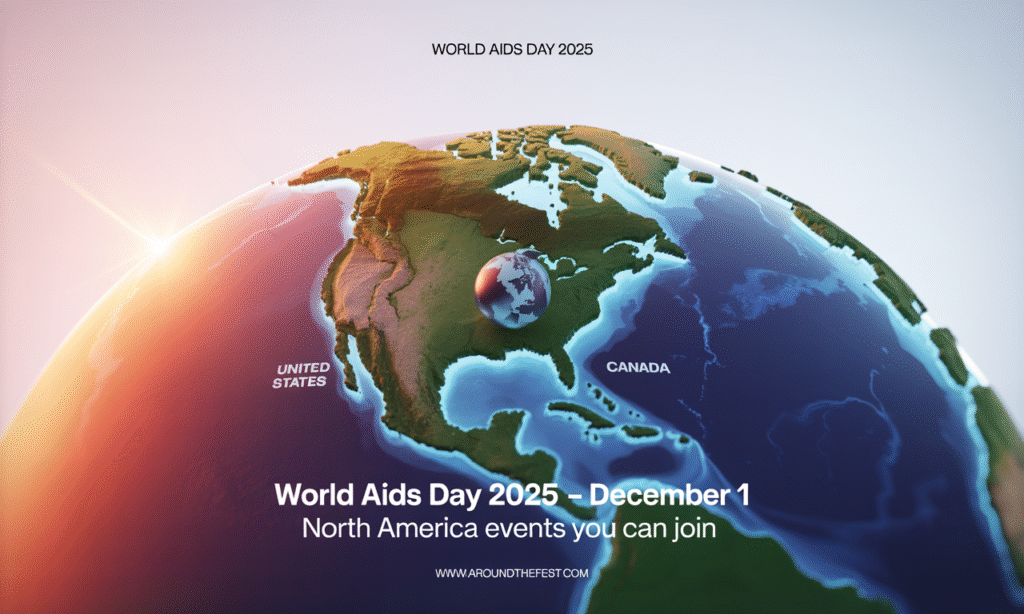
1. United States
Community Rallies & Marches: New York City, Los Angeles, San Francisco, and Chicago host vigils and solidarity marches advocating equal access to healthcare.
Educational Programs: Universities such as Harvard, UCLA, and NYU conduct seminars, workshops, and student awareness campaigns.
Fundraising Events: Charity runs, benefit concerts, bake sales, and online crowdfunding campaigns support research and treatment programs.
High-Profile Galas: The amfAR Venice Gala attracts celebrities and raises millions for HIV/AIDS research.
2. Canada
Awareness Programs: Toronto and Vancouver host community discussions and panels on HIV prevention.
Educational Workshops: Schools organize student-led campaigns and competitions to promote HIV knowledge.
Local Fundraisers: Charity walks, online donation drives, and benefit concerts support local NGOs and healthcare initiatives.
Europe
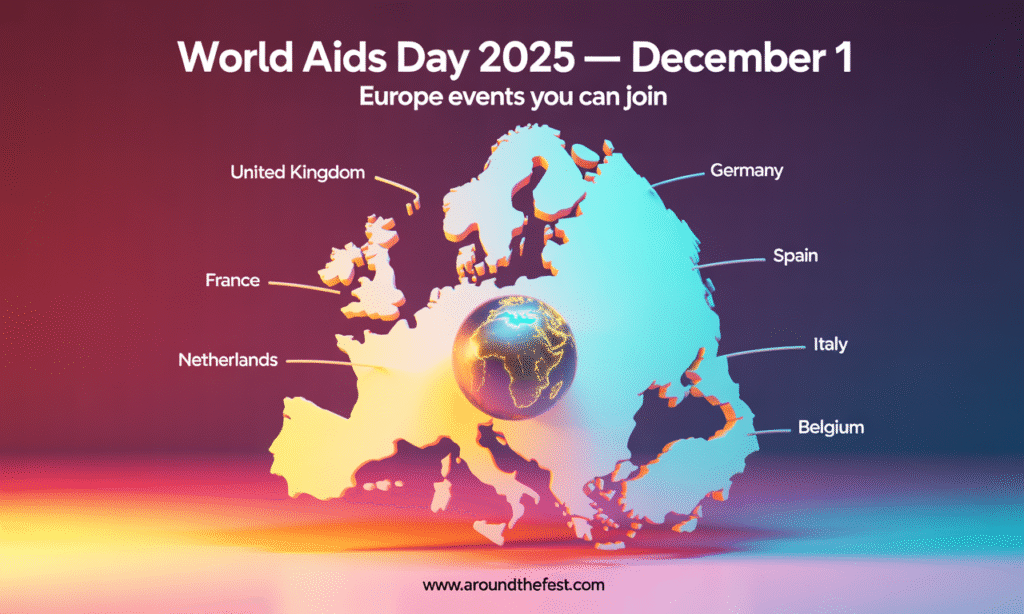
1. United Kingdom
- London hosts street campaigns, seminars, and panel discussions.
- Cultural events include theatre performances and art exhibitions to highlight HIV awareness.
2. France
- Paris organizes a variety of events, including public talks, art exhibitions, and fundraising concerts.
- Collaborative campaigns with NGOs like Sidaction promote testing and treatment access.
3. Germany
Berlin hosts educational programs, film screenings, and interactive workshops for both youth and adults to raise HIV awareness.
4. Spain, Netherlands, Italy, Belgium
- Across various cities, awareness drives, local workshops, and cultural activities are organized for World AIDS Day.
- Universities participate in student-led awareness projects.
Asia & Africa
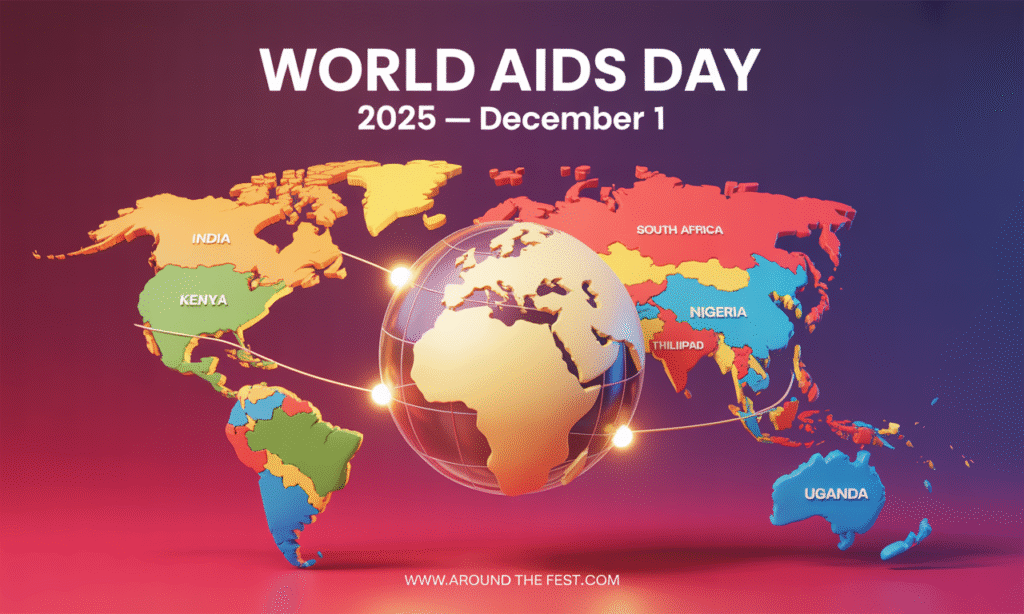
1. India
Meghalaya Youth Uncut: Youth-led programs promoting awareness, testing drives, and community engagement.
Major cities like Delhi, Mumbai, and Bangalore host seminars and health camps.
2. South Africa
- Community vigils, candlelight memorials, and workshops honor those affected and educate communities.
- Johannesburg, Cape Town, and Durban organize large awareness campaigns and testing drives.
3. Kenya & Nigeria
- Youth programs, local theatre, and cultural initiatives raise awareness in rural and urban areas.
- Free HIV testing camps and educational campaigns are held nationwide.
4. Other Countries (e.g., Thailand, Philippines, Uganda)
- Awareness walks, school programs, and community-led campaigns engage local populations.
- Cultural performances and storytelling highlight resilience and preventive measures.
Latin America & Caribbean
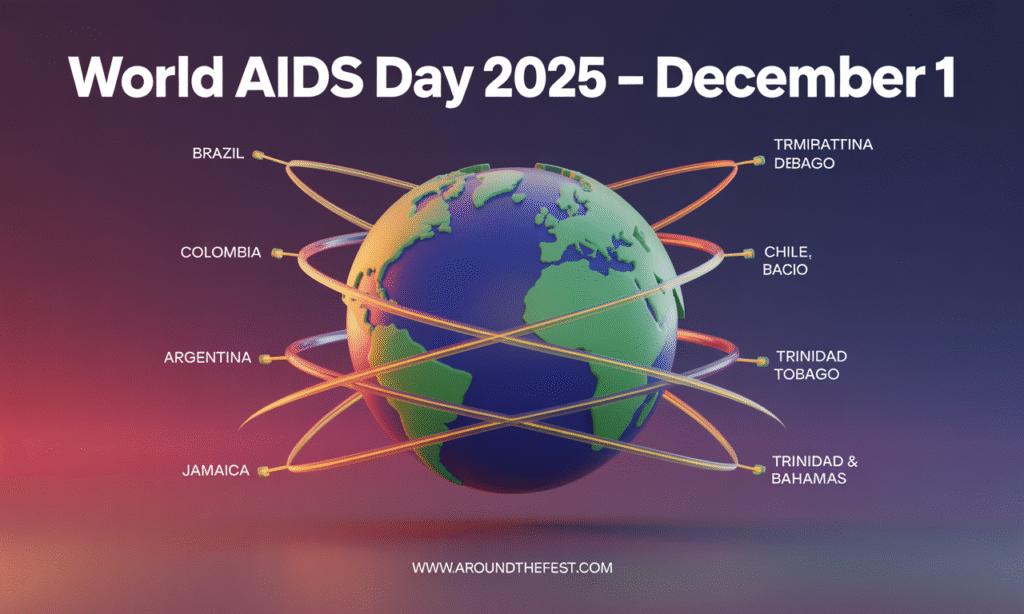
1. Brazil
Music and arts festivals integrate HIV awareness campaigns into performances in São Paulo, Rio de Janeiro, and Brasília.
2. Mexico & Colombia
Community workshops, seminars, and online campaigns educate youth and adults on HIV prevention.
3. Argentina & Chile
Theatre, dance, and music events in Buenos Aires and Santiago engage audiences creatively to reduce stigma.
4. Caribbean Islands (Jamaica, Trinidad & Tobago, Bahamas)
Community rallies, educational programs, and public awareness campaigns target both urban and rural communities.
Oceania
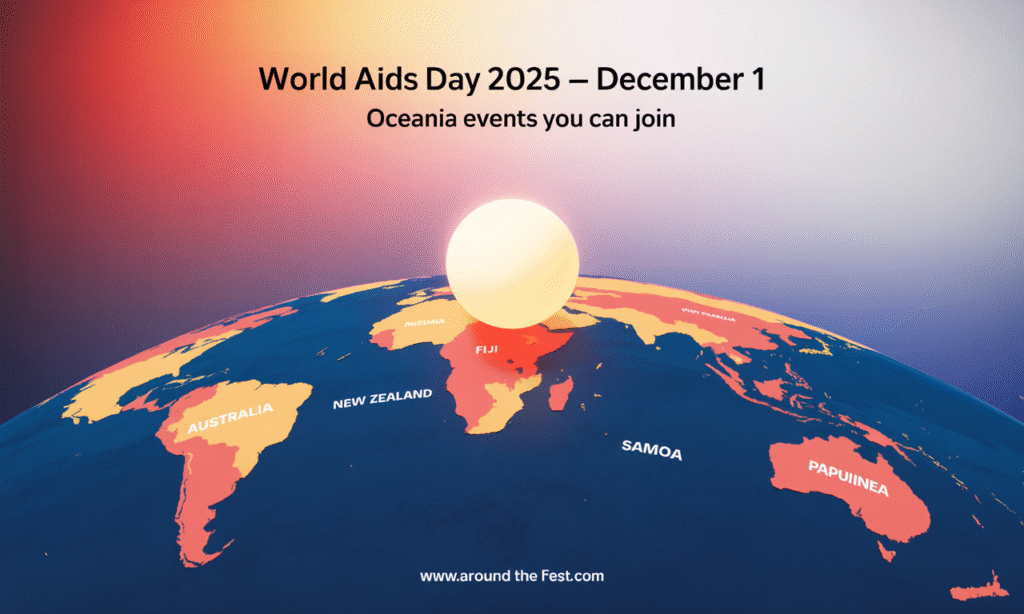
1. Australia
- Sydney and Melbourne organize charity runs, fundraising walks, and awareness workshops to mark World AIDS Day.
- Art exhibits, theatre performances, and storytelling events share personal experiences and raise awareness.
2. New Zealand
Auckland and Wellington host community events, awareness seminars, and youth-led campaigns to promote HIV prevention.
3. Pacific Islands (Fiji, Samoa, Papua New Guinea)
Local outreach programs, school campaigns, and small-scale cultural performances spread HIV awareness.
Online and Virtual Participation
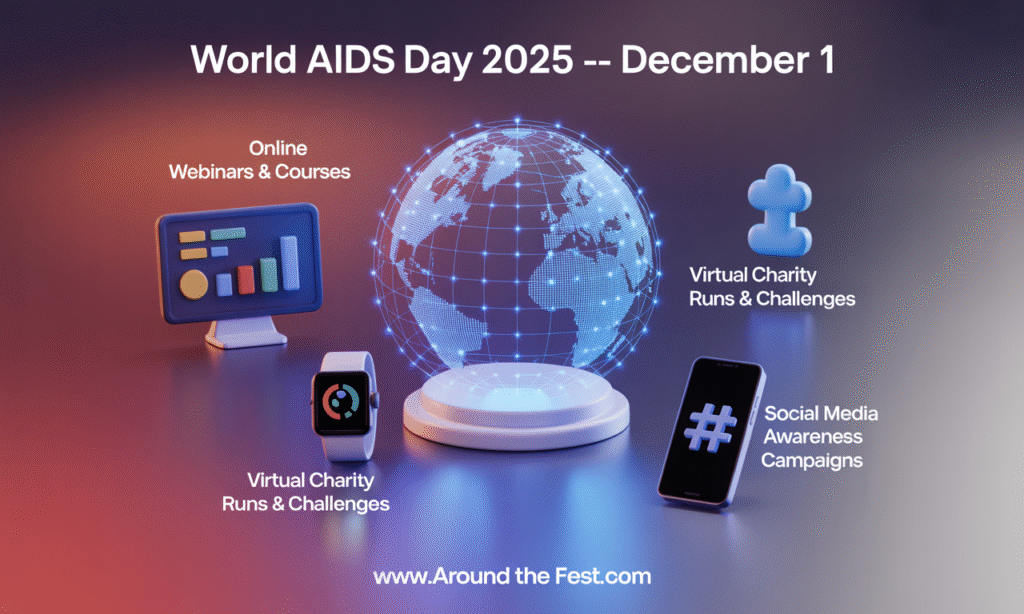
Global Opportunities
Webinars & Online Courses: Expert-led sessions on HIV prevention, treatment, and human rights education.
Virtual Runs & Challenges: Digital charity events allow participants worldwide to contribute.
Social Media Campaigns: Use hashtags like #WorldAIDSDay2025 to share survivor stories, infographics, and educational content.
Why Virtual Participation Matters:
- Connects people globally, including those in remote areas.
- Allows everyone to contribute through donations, volunteering, or spreading awareness online.
- Amplifies local efforts and fosters worldwide solidarity in fighting HIV/AIDS.
Tips for a Safe and Impactful Participation in World AIDS Day 2025 Events
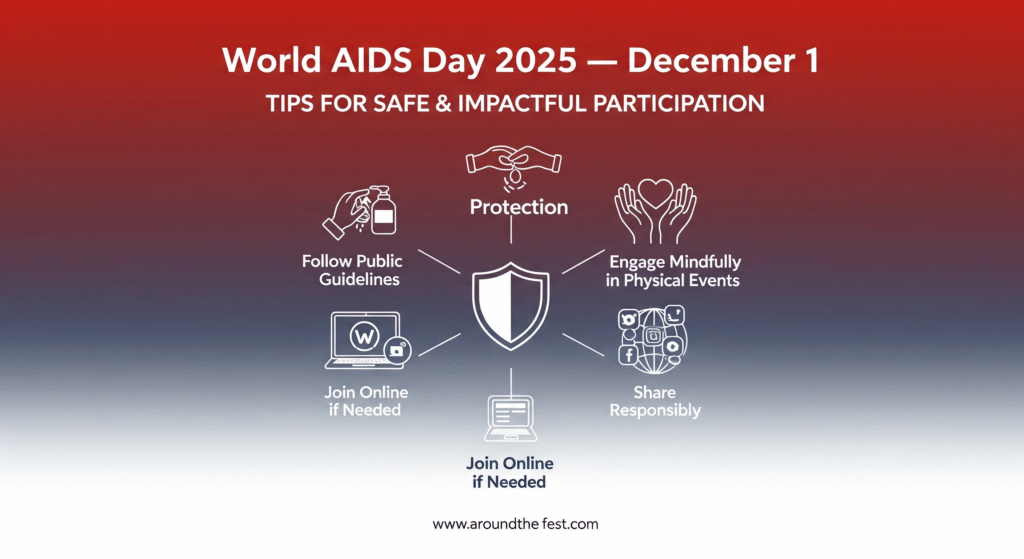
Participating in World AIDS Day 2025 events is meaningful, but it’s important to prioritize safety while maximizing your impact. Here are some essential tips to ensure your involvement is both safe and effective:
1. Follow Public Health Guidelines
COVID-19 and Other Health Precautions: Even if restrictions are relaxed, maintain hand hygiene, wear masks in crowded indoor spaces, and follow local health guidelines.
Event-Specific Protocols: Check with event organizers regarding social distancing, vaccination requirements, or testing protocols to protect yourself and others.
Stay Informed: Keep updated on any local outbreaks or advisories that may affect attendance or event schedules.
2. Contribute Online if You Cannot Attend In-Person
Virtual Webinars and Workshops: Participate in online sessions hosted by UNAIDS, WHO, or local organizations to learn and engage.
Social Media Awareness Campaigns: Share official graphics, facts, survivor stories, and use hashtags like #WorldAIDSDay2025 to amplify your reach.
Online Fundraising: Donate to reputable organizations or set up digital fundraising campaigns to support research, treatment, and community programs.
3. Promote Awareness Responsibly on Social Media
Fact-Check Before Sharing: Ensure all information about HIV prevention, testing, or treatment comes from credible sources.
Respect Privacy and Sensitivity: Avoid sharing personal stories or photos of affected individuals without consent.
Encourage Positive Action: Use posts to motivate followers to attend events, get tested, or support local initiatives rather than just sharing general information.
4. Engage Mindfully in Physical Events
Respect Boundaries: Be considerate during vigils, marches, or workshops. Follow organizers’ instructions for smooth participation.
Support Local Communities: Participate in ways that genuinely benefit the community, such as volunteering at information booths or assisting with event logistics.
5. Combine Online and Offline Efforts
Attend smaller local events and simultaneously engage in online campaigns to maximize impact.
Share your experiences post-event to inspire others and maintain awareness beyond December 1.
Resources and Official Organizations for World AIDS Day 2025
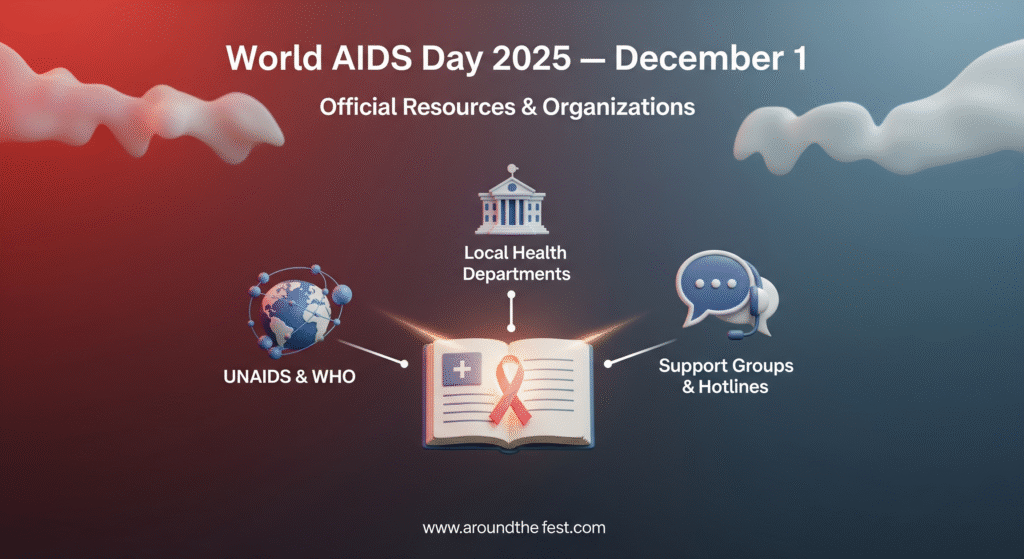
Accessing reliable information and support is key to making the most of World AIDS Day 2025 events. Here are the main organizations and resources to guide your participation, education, and advocacy efforts:
UNAIDS and WHO
Purpose: These global organizations lead international efforts to prevent HIV, improve treatment, and promote awareness.
What They Offer:
- Official announcements for World AIDS Day 2025 events worldwide.
- Up-to-date prevention guidelines, statistics, and research insights.
- Educational materials for schools, communities, and workplaces.
How to Access:
UNAIDS Official Website
World Health Organization – HIV/AIDS
Local Health Departments
Purpose: Local authorities organize in-person awareness programs, testing camps, and health education initiatives.
What They Offer:
- Information on community events, workshops, and vigils in your city or region.
- Access to HIV testing centers and counseling services.
- Guidance on local safety protocols for attending events.
How to Access:
- Visit your city or state health department website.
- Contact local clinics or hospitals for event schedules and HIV resources.
Support Groups and Hotlines
Purpose: Provide emotional, medical, and social support for people living with HIV/AIDS and their families.
What They Offer:
- Peer support groups, counseling sessions, and community networks.
- Helplines for urgent questions, guidance, and mental health support.
- Resources for legal, educational, and financial assistance.
Examples:
- National AIDS Helpline (USA): 1-800-232-4636
- NAM Aidsmap Support Resources (UK): www.aidsmap.com
- Local HIV/AIDS organizations in your city or region can also provide tailored support.
(FAQ) About World AIDS Day 2025 Events and Activities
Q1. When is World AIDS Day 2025?
Ans. World AIDS Day is observed annually on December 1st, and 2025 is no exception. This day is dedicated to raising awareness, honoring those affected by HIV/AIDS, and promoting global prevention and treatment efforts.
Q2. What is the theme for 2025?
Ans. The official theme for World AIDS Day 2025 has not yet been officially announced by the WHO OR UN. It emphasizes that everyone has the right to access accurate health information, HIV testing, and treatment, highlighting the importance of informed participation.
Q3. How can I contribute if I am not in a city hosting events?
Ans. Even if you cannot attend in-person activities, there are plenty of ways to participate:
- Join online webinars, virtual runs, or educational sessions.
- Engage in social media campaigns using hashtags like #WorldAIDSDay2025.
- Make a donation to reputable organizations supporting HIV prevention and care.
Q4. Are virtual events counted as participation?
Ans. Yes! Virtual participation is recognized as meaningful engagement. You can attend online workshops, awareness campaigns, or fundraising events. Sharing and promoting these events also amplifies their impact globally.
Q5. How to access HIV prevention resources safely?
Ans. Use official websites like UNAIDS and WHO for accurate information.
Contact local health departments for testing, counseling, and community programs.
Participate in online educational programs and verified social media campaigns to ensure credibility.
Conclusion: Join the Fight: World AIDS Day 2025
World AIDS Day 2025 is more than a date on the calendar—it’s a chance to take meaningful action. By participating in local events, joining virtual campaigns, or supporting fundraisers, you contribute to a global effort that reduces HIV infections, fights stigma, and empowers communities.
Every effort counts. Sharing knowledge, attending workshops, or even posting on social media can spark awareness and inspire others to act. Together, we can create stronger, informed, and compassionate communities ready to face HIV/AIDS head-on.
This December 1st, take the step from awareness to action—engage, advocate, and make a difference in the fight against HIV/AIDS.

